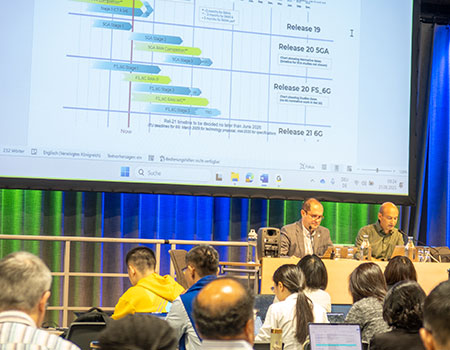By Rashmi Kamran Bhatia, IIT Bombay
First published Oct. 2022, in Highlights Issue 05
Mobile Base Station Relay (MBSR) is a lucrative option to extend network coverage and support enhanced capacity. A prime use case of MBSR is Vehicle Mounted Relay (VMR) to provide connectivity to users inside or nearby outside the vehicle. The requirements for MBSRs are provided in 3GPP TS 22.261 (stage 1), focusing on efficient mobility and service continuity for connected users in different scenarios. While the stage 1 requirements allow for both IAB and non-IAB based architectures, the stage 2 development in 3GPP Release 18 has considered IAB-based architecture only.
TSDSI has undertaken a new work item on a non-IAB-based relay solution which can support on-demand relay and MBSR functionality with minimal changes to the existing network elements and interfaces. This solution proposes a new way of connecting gNB-DU and gNB-CU and placing them differently from the conventional 3GPP architecture. gNB-DU is placed at MBSR, and the corresponding gNB-CU, called MBSR-gNB-CU, is placed in the edge cloud. MBSR comprises the gNB-DU functionality along with an additional UE (Mobile Termination (MT)) stack to enable IP connectivity with MBSR-gNB-CU. A unique feature of the TSDSI solution is that it utilizes the 5G system's PDU connectivity service to connect the MBSR (gNB-DU) to the corresponding MBSR-gNB-CU as shown in Figure 1. The F1 interface between the gNB-DU and gNB-CU is carried in the PDU session established between MBSR (MT) and MBSR-gNB-CU via the 5G system.
Figure 1 shows the working of this solution for the VMR use case. Initially, the MT of the MBSR is connected to gNB1 over the radio (Uu) interface, and its PDU session(s) to the MBSR-gNB-CU are established via gNB1 and UPF1. Multiple UEs within the vehicle are connected to gNB-DU of the MBSR (VMR) through NR interface. For all UEs connected to gNB-DU of MBSR, the MBSR-gNB-CU acts as gNB-CU (also illustrated in Figure 1).

Figure 1: Working of the solution for the VMR handover scenario
When the MBSR moves and gets closer to gNB2, a conventional UE handover is triggered between gNB1 and gNB2 for the MBSR (MT function). However, the PDU session(s) between the MBSR and MBSR-gNB-CU do not get impacted due to the handover, hence there is no disruption in the IP and F1 connectivity between the two entities. Since the UEs within the MBSR (VMR) move along with the VMR, it essentially is a no mobility scenario for the UEs as they remain connected to the same gNB-DU (MBSR) and the same gNB-CU (MBSR-gNB-CU) despite the mobility of the MBSR. Therefore, there is no handover signaling for the connected UEs. This simplicity and no impact on service continuity for UEs make it a viable option for non-IAB based MBSR solution for future 3GPP releases also.
The author would like to acknowledge Prof. Abhay Karandikar, Prof. Prasanna Chaporkar, Mr. Pranav Jha, Mr. Shashi Ranjan and Ms. Shwetha Kiran for their contribution.


 Partners News
Partners News 




